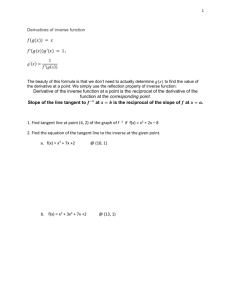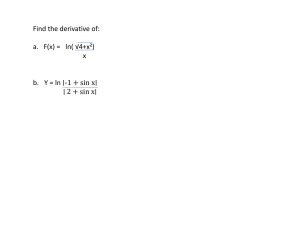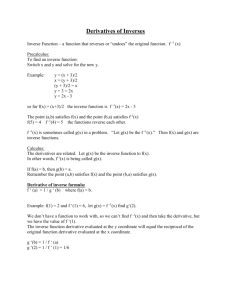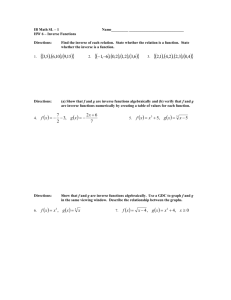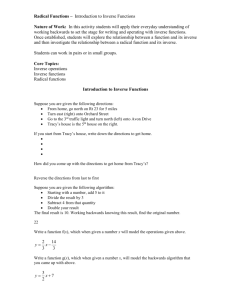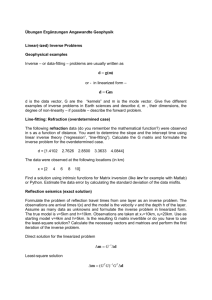lesson 25--derivative of inverse functions
advertisement
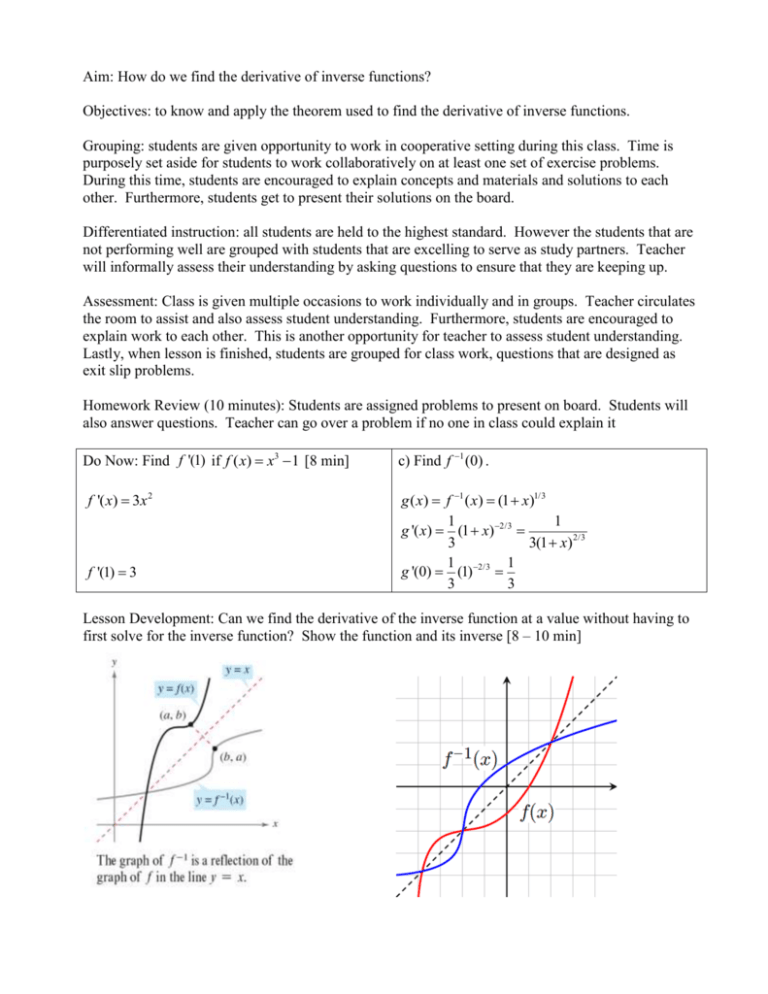
Aim: How do we find the derivative of inverse functions? Objectives: to know and apply the theorem used to find the derivative of inverse functions. Grouping: students are given opportunity to work in cooperative setting during this class. Time is purposely set aside for students to work collaboratively on at least one set of exercise problems. During this time, students are encouraged to explain concepts and materials and solutions to each other. Furthermore, students get to present their solutions on the board. Differentiated instruction: all students are held to the highest standard. However the students that are not performing well are grouped with students that are excelling to serve as study partners. Teacher will informally assess their understanding by asking questions to ensure that they are keeping up. Assessment: Class is given multiple occasions to work individually and in groups. Teacher circulates the room to assist and also assess student understanding. Furthermore, students are encouraged to explain work to each other. This is another opportunity for teacher to assess student understanding. Lastly, when lesson is finished, students are grouped for class work, questions that are designed as exit slip problems. Homework Review (10 minutes): Students are assigned problems to present on board. Students will also answer questions. Teacher can go over a problem if no one in class could explain it Do Now: Find f '(1) if f ( x) x3 1 [8 min] f '( x) 3x 2 f '(1) 3 c) Find f 1 (0) . g ( x) f 1 ( x) (1 x)1/3 1 1 g '( x) (1 x) 2/3 3 3(1 x)2/3 1 1 g '(0) (1) 2/3 3 3 Lesson Development: Can we find the derivative of the inverse function at a value without having to first solve for the inverse function? Show the function and its inverse [8 – 10 min] What do you notice about the slope of tangent line to the function and its inverse? They share the same sign. Is there further connection? Theorem: Let f be a function that is differentiable on an interval [a, b]. if f has an inverse function g ( x) f 1 ( x) , then g is differentiable at any x ( f 1 ) '( x) 1 1 , f '( g ( x)) 0 or g '(b) , f '(a ) 0 f '( g ( x)) f '(a) Example A: f '( x) 3x 2 0 x3 1 x 1 g '(0) [4 min] 1 1 f '(1) 3 Example B: The function f ( x) x3 2 x 1 has an inverse function, f 1 ( x) . Find ( f 1 ) '(2) [6 min] To apply the theorem, we must find the corresponding x-value to y = 2. f '( x) 3x 2 2 ( f 1 ) '(2) 1 1 2 3(1) 2 5 2 x3 2 x 1 [solve for x on the graphing calculator] x 1 EX1: The function f ( x) x 4 has an inverse function, f 1 ( x) . Find ( f 1 ) '(2) [6 – 8 min] 2 x4 4 x4 x 8 1 f '( x) ( x 4) 1/2 2 ( f-1)’(2) = 1/ f ’(x) 1(8 4)0.5 ( f ) '(2) 4 0.5 1 4 has the inverse function f 1 ( x) on the interval (0, ) . Find the line 1 x2 tangent to the graph of ( f 1 ) '( x) at (2, 1). [6 – 8 min] EX2: The function f ( x) f ( x) 4(1 x 2 )1 ( f 1 ) '(2) f '( x) 4(1 x 2 )2 (2 x) 1(1 1)2 1 8 2 1 y 1 ( x 2) 2 EX3: The function f ( x) 3 4 x has the inverse function f 1 ( x) . Find the line tangent to the graph of ( f 1 )( x) at (-1, 1). [6 – 8 min] f '( x) 4 ( f 1 ) '(1) HW#25: P179 – 181: 1, 2, 5, 6. 1 1 f '(1) 4 1 y 1 ( x 1) 4 HW#25 Solutions: P179 – 181: 1 1) ( f ) '(2) 5 1 1 2) ( f ) '(11) 17 1 1 5) ( f ) '(6) 13 1 6) ( f 1 ) '(2) 4
